Scythe Andy Samurai Master vs. Thermaltake MaxOrb
by Wesley Fink on June 4, 2007 5:00 AM EST- Posted in
- Cases/Cooling/PSUs
Thermaltake MaxOrb
Thermaltake started business in 1999 in Taiwan, and has since become one of the most recognized brands in computer cooling as well as cases. Since 1999 the company has grown into a world-class company with a state-of-the-art testing and R&D facility based in Taiwan. Thermaltake employs 60+ engineers covering each application segment such as Liquid Cooling, Air Cooling, PC Enclosure and Power Supply for main-stream users, high-end solutions, system integrators and industrial applications. Today you will find Thermaltake cooling solutions around the world.
The MaxOrb is the latest in a long line of Thermaltake "orb" coolers. The Orb name was first used in 2000 when Thermaltake launched the Golden Orb cooler for Pentium processors. The name has been revived recently with the MaxOrb cooler, which combines radial fins and heatpipes in a down-facing CPU cooler.
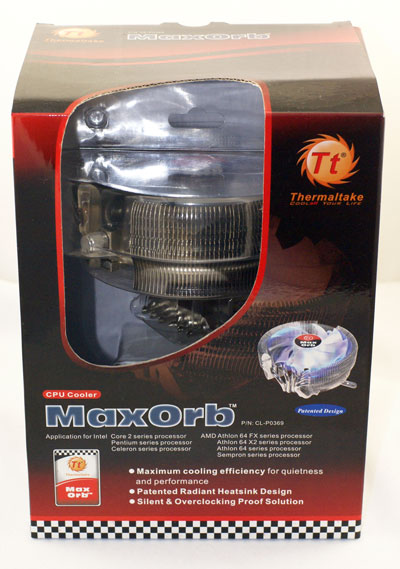
This cooler stands out with distinctive red and black packaging, and the package itself is huge. The MaxOrb and a box of accessories are protected by a plastic clamshell inside the box.
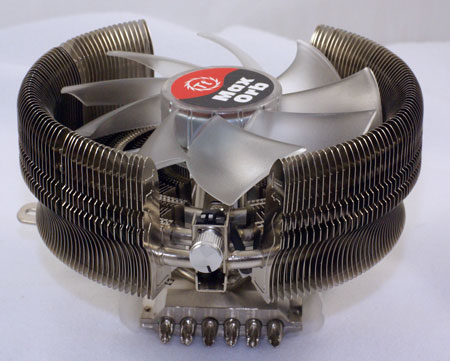
The cooler uses large radial aluminum fins and a large 110mm fan. As you can see there is also a built-in fan speed control that allows fan output to be adjusted up to a claimed 86.5cfm at 2000rpm. The embedded 110mm fan is lit by a blue LED. 110mm is a non-standard fan size, but that is somewhat a moot point since the fan was not designed to be changed.
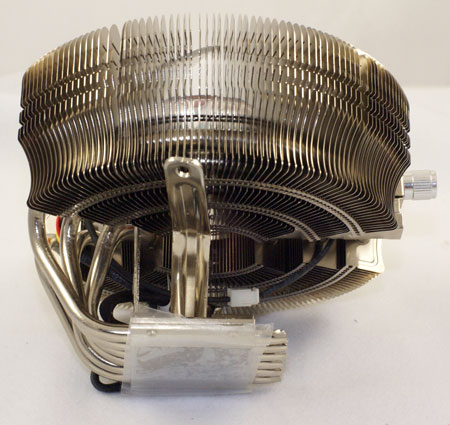
The cooling is further enhanced by six heatpipes extending from the copper base. These turn and pass horizontally through the radial fins to dissipate heat from the processor.
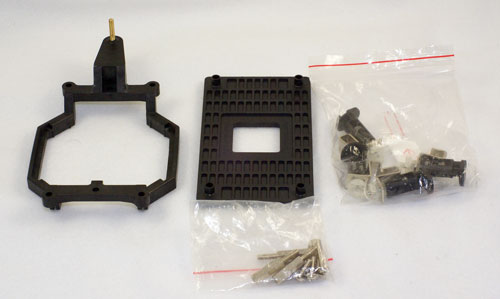
Accessories include mounting brackets for Intel socket 775 and AMD 754/939/940/AM2. The key component is the universal mounting base.
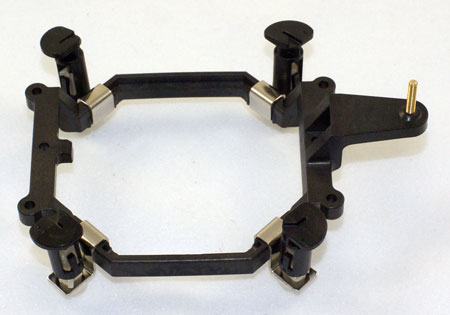
The base attaches the MaxOrb cooler, and four pop-clips slip onto the base for mounting to an Intel socket 775. You don't need to remove the motherboard to mount this cooler.

The base pops on first, then the cooler attaches by clipping to the base lug and attaching a single screw. Unlike other coolers that claim simple installation without board removal, this one actually works. The only awkward task is attaching the single screw since there's just no good way on a board mounted in a case to hold the screw while trying to screw it on.
Specifications
Our test system is Intel socket 775, but the Thermaltake MaxOrb will mount on any recent AMD socket as well - including socket 754/939/940 as well as the more recent and AM2. All the needed hardware is included.
The MaxOrb is a big cooler, but it is much shorter than the typical heatsink towers we have been reviewing. The EVGA 680i is a difficult to fit board due to the copper-finned heatsink and fan cooling the Northbridge. It is a snug fit, but the MaxOrb mounted fine on the 680i, the ASUS Striker and ASUS Commando, and on the two new P35 boards - the ASUS P5K Deluxe and P5K3 Deluxe. The P5K3 Deluxe is almost a fit test for any motherboard, since the heatpipes completely circle the CPU socket and connect various cooling heatsinks around the CPU socket. The only precaution on the P5K3 is to mount the MaxOrb with the screw "tongue" over the lower heatpipes near the DIMM sockets. It clears everything in this mount position.
Thermaltake started business in 1999 in Taiwan, and has since become one of the most recognized brands in computer cooling as well as cases. Since 1999 the company has grown into a world-class company with a state-of-the-art testing and R&D facility based in Taiwan. Thermaltake employs 60+ engineers covering each application segment such as Liquid Cooling, Air Cooling, PC Enclosure and Power Supply for main-stream users, high-end solutions, system integrators and industrial applications. Today you will find Thermaltake cooling solutions around the world.
The MaxOrb is the latest in a long line of Thermaltake "orb" coolers. The Orb name was first used in 2000 when Thermaltake launched the Golden Orb cooler for Pentium processors. The name has been revived recently with the MaxOrb cooler, which combines radial fins and heatpipes in a down-facing CPU cooler.

This cooler stands out with distinctive red and black packaging, and the package itself is huge. The MaxOrb and a box of accessories are protected by a plastic clamshell inside the box.

The cooler uses large radial aluminum fins and a large 110mm fan. As you can see there is also a built-in fan speed control that allows fan output to be adjusted up to a claimed 86.5cfm at 2000rpm. The embedded 110mm fan is lit by a blue LED. 110mm is a non-standard fan size, but that is somewhat a moot point since the fan was not designed to be changed.

The cooling is further enhanced by six heatpipes extending from the copper base. These turn and pass horizontally through the radial fins to dissipate heat from the processor.

Accessories include mounting brackets for Intel socket 775 and AMD 754/939/940/AM2. The key component is the universal mounting base.

The base attaches the MaxOrb cooler, and four pop-clips slip onto the base for mounting to an Intel socket 775. You don't need to remove the motherboard to mount this cooler.

The base pops on first, then the cooler attaches by clipping to the base lug and attaching a single screw. Unlike other coolers that claim simple installation without board removal, this one actually works. The only awkward task is attaching the single screw since there's just no good way on a board mounted in a case to hold the screw while trying to screw it on.
Specifications
Our test system is Intel socket 775, but the Thermaltake MaxOrb will mount on any recent AMD socket as well - including socket 754/939/940 as well as the more recent and AM2. All the needed hardware is included.
| Thermaltake MaxOrb Specifications | ||||
| Heatsink | ||||
| Dimensions | 143(L) X 114(D) X 85.2(H)mm | |||
| Weight | 465g (including fan) | |||
| Material | Pure Copper Base and Aluminum Fins | |||
| Heatpipes | Six 6mm copper heatpipes | |||
| Fan | ||||
| Fan Size | 110 mm x 25mm | |||
| Bearing Type | Sleeve Bearing | |||
| Fan Life | 50,000 hours | |||
| Connector | 3-pin with integral fan-speed rheostat, 3.0 Watt Input | |||
| Speed | Silent Mode | 1,300rpm | Low-noise Mode | 2,000rpm |
| Noise Level | Silent Mode | 16.0dBA | Low-noise Mode | 24.0dBA |
| Fan Output | Silent Mode | Low-noise Mode | 85.5cfm | |
The MaxOrb is a big cooler, but it is much shorter than the typical heatsink towers we have been reviewing. The EVGA 680i is a difficult to fit board due to the copper-finned heatsink and fan cooling the Northbridge. It is a snug fit, but the MaxOrb mounted fine on the 680i, the ASUS Striker and ASUS Commando, and on the two new P35 boards - the ASUS P5K Deluxe and P5K3 Deluxe. The P5K3 Deluxe is almost a fit test for any motherboard, since the heatpipes completely circle the CPU socket and connect various cooling heatsinks around the CPU socket. The only precaution on the P5K3 is to mount the MaxOrb with the screw "tongue" over the lower heatpipes near the DIMM sockets. It clears everything in this mount position.










50 Comments
View All Comments
lopri - Tuesday, June 5, 2007 - link
I've always thought the benefit of the blowing-down design is that it 'moves' hot air around MOSFET/VRM/NB area better, therefore contributing to long-term (be it hours or years) stability. I haven't seen an argument that these blowing down HSFs let a CPU clock better than the top offerings from L-shaped design for 30 min. gaming session. (It actually explains a lot other things because up to this date I assumed the load temps were measured under 100% of load - for both cores.)Question for Wesley: Could you confirm how much stress the CPU is taking with your test scenario? Maybe using percentage. (like 50%, 60%, etc.)
Another issue with the Wesley's conclusion is that he forgets the boards built on NF6 chipsets are probably the only boards that come equipped with NB fans. If you look around, vast majority of LGA775 boards don't have a NB fan. As a matter of fact I don't think I remember any 975X/P965 board that has a NB fan. And in AT's own motherboard reviews, I often read statements like "In order to maintain stability, additional airflow was required for the board's MCH...". And these L-shaped HSFs don't provide that required airflow for the MCH.
I do think there is an agreement among enthusiasts that these L-shaped HSF are better for higher CPU overclocking and/or lower CPU temperatures. But the question is, are you comfortable with VRM that reaches 100C+ for an extended period? How about the board's northbridge that goes beyond 50~100C depending on chipsets? As a matter of fact, the NB of the motherboard that is used on this very review is capable of reaching 100C without overclocking, unless the supplied 'optional' fan is used. (in other words, that 'optional' fan isn't really an option but a must, irrespective of overclocking - if you want to keep the board for more than just a few months)
In my opinion, the conclusion of this article is severely misleading from many angles. Also my experience disagrees with Wesley's finding that higher RPM fans didn't change the performance of Scythe Andy heatsink, but that's a different issue, I guess.
Wesley Fink - Tuesday, June 5, 2007 - link
As stated on p.4, CPU Colling Test Configuration, "The CPU stress testing with TAT pushing both cores showed TAT stress temps at 80% CPU usage roughly corresponded to temps reported in our real-world gaming benchmark."redeyedrob - Monday, June 4, 2007 - link
Be interesting to see a comparison of Northbridge temps between the horizontal and vertical coolers, maybe even a comparison of max FSB speeds resulting from any potential difference in max NB voltages / stability between the 2 cooler types.I have an E660 @ 2.4 - 2.8 GHz with an Ultra 120 Extreme which idles at 30 degrees (almost certainly due to the terrible curvature on the base, need to lap) but the NB is idling at 44 degrees.
SurJector - Monday, June 4, 2007 - link
From 3.83GHz to 3.90GHz is 1.83%From 3.83GHz to 3.96GHz is 3.39%
Apart for bragging rights, is anybody able to tell the difference ?
Wesley Fink - Monday, June 4, 2007 - link
As explained in our very first cooler review with Core 2 Duo, the Intel stock fan can do a 3.73GHz overclcok. That is why that is the baseline. If a cooler can't outperform the Intel stock cooler then why should you buy it? If this suggests it doean't make sense to go for more than the excellent Intel retail cooler then we can appreciate your thinking.However, this is just one component of cooler perfromance, and you should also look at the cooling efficiency in our cooler tests. The Thermalright Ultra 120 eXtreme with an S-Flex fan under LOAD at 3.73GHz cooled to 43C compared to the Intel at 71C. That's a 40% or 65% improvement in cooling perfroamnce depending on what you consider the baseline.
SurJector - Tuesday, June 5, 2007 - link
The temperature difference (43C against 71C) is indeed important. I feel much better with a cooler CPU.The point is when one says "cooler A allows the CPU to reach 3960MHz while cooler B goes only to 3830 thus cooler A is much better". I think it is not much better, it is a little bit better but those 3.4% do not justify any price difference. What is the margin of error of that measure ? Isn't it higher than 3.4% ?
28C difference do justify a price difference.
10dB as well.
Martimus - Monday, June 4, 2007 - link
The biggest problem with blowing air back down onto your chip is that you are blowing ht HOT air back onto the component you are trying to cool. It would make a WHOLE LOT MORE SENSE to turn the fan around and blow the air away from the component. This would cause the same amount of airflow through the heatsink, and even cause the same air to be cool the other components on the MB except it wouldn't have been heated by the heatsink first. I can't understand why the manufacturer would suggest blowing the air towards the chip and not away from it. It goes against common sense.strikeback03 - Tuesday, June 5, 2007 - link
Depends how warm the motherboard components in question are. If component X is at 50*C and the air around it is stagnant, then that air will quickly heat up and the component will get warmer. Since the exhaust air from the CPU heatsink does not get warmed much, you get a flow of air around component X which is a constant temperature and typically much less than 50*C. If your motherboard components are hardly above ambient, or you have ambient air forced across the motherboard from some other source, then the air off the CPU HSF could cause components to warm up, and a down-facing fan would be a bad idea.To whoever reoriented their heatsink: Was the fan flipped in place? Moved to the other side of the heatsink? Any difference in noise? I have noticed some fans are louder depending on which side has a grill or fins nearby.
Martimus - Wednesday, June 6, 2007 - link
You could just turn the fan around and blow it away from the component. It would give the exact same airflow as if it was pointed toward the component, except in the opposite direction. This would also avaoid the problem of blowing hot air back onto the component.strikeback03 - Thursday, June 7, 2007 - link
Unless there was a fan somewhere forcing air across the motherboard for the CPU fan to remove, it is doubtful the outward-facing fan would move nearly as much air at the motherboard surface. Surface of the motherboard is too crowded with stuff for air to naturally flow nicely across it.